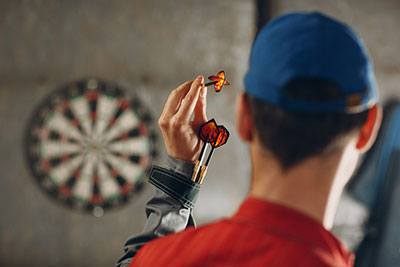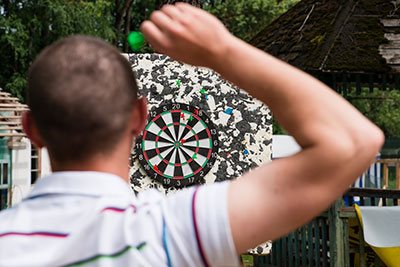Darts is a game that requires precision, accuracy, and practice. Whether you're a beginner or a seasoned pro, practicing darts can help improve your skills and take your dart game to the next level.
But with so many different techniques and strategies out there, it can be difficult to know where to start.
In this blog post, we'll explore the art of practicing darts as well as exercises for playing darts.
From mastering your aim to creating a winning mindset, we'll cover everything you need to know to become a better darts player through consistent practice. So grab your darts and let's dive in!
More...
Take away key points:
- Set specific goals for each practice session with confidence.
- Get the right equipment, including a quality dartboard and darts with the right weight and shape for your match play darts.
- Focus on technique, not just throwing as many darts as possible.
- Use a practice board or dartboard ring to help you focus on specific areas of around the board. This will allow for good practice as well as muscle memory.
- Don't worry about making small adjustments after each throw. Simply reflecting on your previous throw will help you improve much faster than you would otherwise.
- Adding software to your computer that allows you to record your shots and provides a virtual opponent can greatly enhance your practice regimen.
- Remember to practice finishing just as how you practice doubles.
- Practice regularly, but don't overdo it - experts recommend practicing for at least 30 minutes to an hour each day and take a short break. Don't throw countless darts hoping to improve your game.
Understanding the basics of dart practice
Millions of people around the world enjoy playing darts. It is not only a dart game of skill but also requires practice and preparation to improve and master your throwing darts skills.
The basics of darts practice involve understanding the fundamentals of the game, such as the dart board, scoring system, throwing technique, and strategic planning.
To be successful in darts, you must focus on your target, stay consistent with your throwing motion, and learn to adjust your aim based on your opponent's moves. With regular practice and dedication, anyone can become a skilled dart player and enjoy the thrill of hitting the bullseye. This is the best advice for beginners that are looking to hit the double on the way to their practice routine.
The importance of goal setting in darts practice

Darts may seem casual and relaxed, but don't let that fool you - it requires focus, strategy, and, most importantly, goal setting. It's not just about aiming for the bullseye or hitting the 180s.
With regular practice sessions, goals help intermediate players identify areas that need improvement and create a plan to work towards achieving them. This could be anything from perfecting a particular throwing technique to increasing accuracy or becoming more consistent overall.
Goals motivate intermediate players to push themselves further, and the sense of accomplishment that comes with each achievement can be both immensely satisfying and a catalyst to drive further progress.
So the next time you're headed to play a few rounds of darts, remember to set some goals - you might be surprised at the difference it makes!
Strategies for effective dartboard placement
When it comes to placing a dartboard, there are various strategies to keep in mind to ensure a safe and effective game.
Firstly, choosing a spacious and well-lit area to install the dartboard is crucial. Dart players require ample space to throw darts smoothly and avoid collisions with other players or objects in the room.
Secondly, the height of the dartboard should be accurate, preferably at 5 feet and 8 inches from the floor to the bullseye. This height ensures that most players can comfortably reach and throw their darts at the board.
Additionally, when positioning the dartboard, it is advisable to avoid direct sunlight or glaring overhead lights that can cause distractions or affect the players' eyesight.
Lastly, consider purchasing a dartboard backing board that can protect the wall behind the board from dents and scratches due to missed dart throws.
By implementing these strategies, you can enjoy a safe and enjoyable game of darts while preserving your dartboard's longevity.
Hitting high-scores, checkout & doubles

Hitting high scores, checkout, and practice doubles in darts is a skill that requires a lot of practice and dedication.
The first step to improving these skills is to understand the basics of the game. One of the main ways to hit high scores is to aim for the triple 20. This makes the highest possible score in a single throw.
To hit the checkout, you will need to calculate the remaining points and choose a combination of darts that will bring the total to zero.
For instance, if you have 47 points left, you could aim for triple 15, double 16, or triple 19 and double 5. When it comes to practice doubles and hit the double, the most common ones are double 20, double 16, double 10, and double 8. The game is over if you have hit all the doubles in this order.
Players can start by practicing their throwing technique, stance, and grip on the dart to improve. You can also practice calculating the best combinations to achieve the checkout. Make sure to darts practice routines consistently and dedicate time each day to your training routine.
Mastering your aim: tips and techniques for better accuracy
1. Find the right grip: Your grip on the dart is crucial to achieving accuracy. Experiment with different grips to find the one that suits you best.
2. Stand correctly: Positioning yourself correctly is essential to achieving consistent accuracy. Stand with your feet shoulder-width apart and ensure that your throwing shoulder is aligned with the target.
3. Focus on your target: Visualize where you want the dart to land and focus on hitting that spot. Your eyes should be fixed on your target throughout the throw.
4. Practice regularly: Dart practice makes perfect, and the more you practice, the better you'll become. Try to establish a consistent throwing routine and practice hitting regularly.
5. Improve your stance: Make sure that your stance is stable and balanced. Your weight should be evenly distributed between both feet, and your body should be relaxed.
6. Develop a pre-throw routine: Establishing a pre-throw routine can help you to focus and prepare mentally for your throw. This can include taking a deep breath, visualizing the throw and tapping the dart on your forehead before releasing.
7. Learn to read the board: Knowing how to read the board can help you to adjust your aim and improve your accuracy. Pay attention to how your darts land to make adjustments on your next throw.
The art of visualization in darts practice

The art of visualization is a crucial element in darts practice routines that can greatly enhance a player's skills and performance.
Visualization involves mentally picturing every aspect of the throw before actually executing it on the board.
More advanced players have been using this method for years, and it is one of the best ways to increase accuracy and aim.
By visualizing the trajectory of the dart, the strength needed for the throw and the optimal placement on the board, the player can execute a nearly perfect throw with each attempt.
This art requires practice, focus, and dedication, but the rewards are significant, as the advanced players in the world attribute their success to a disciplined, well-trained mind that can visualize every aspect of the game while shooting big scores!
The most effective practice games & drills
1. Around the world: players aim at the outer edge of the board and then move inward, hitting each number in sequential order until they reach the bullseye. This practice game drill helps to improve accuracy and consistency.
2. Cricket: a popular game played on the dartboard where players must hit specific numbers to score points. This drill improves counting and strategic thinking.
3. Bob's 27: a practice game where players must hit each number, from 1 to 20, three times, as well as the bullseye three times with three darts, to score a perfect 81. This drill improves aim and endurance. To play Bob's 27, begin by aiming for the single 1 on the board and throw three darts. If you hit the single 1, move on to the next number (2). If you miss the single 1, start over at 1. Continue in this way until you have hit all of the numbers from 1 to 27 in order.
You can use any combination of singles, doubles, or triples to hit each number, but you must hit each number with three darts or fewer. Once you have hit all the numbers, your score is the total number of darts it took you to complete the game.
4. Shanghai: players aim for a specific number on each turn (for example, turn one could be all about hitting the triple 20), and if they hit a different number or miss completely, their turn is over. This darts practice routines drill improves focus and accuracy under pressure.
5. Half-It: a game where players must hit specific numbers to score points, but if they hit a double one, they can choose to "half" their score for that round. This drill improves accuracy and decision-making.
Common mistakes to avoid when practicing darts
When practicing darts, there are a number of common mistakes that players tend to make, which can significantly impact their performance.
Here are some of the most crucial things to avoid:
1. Gripping the dart too tightly: Many players tend to hold their dart too tightly, which can lead to tension and loss of control. Instead, hold the dart with a relaxed grip and allow your fingers to guide the throw.
2. Improper stance: Your stance plays a crucial role in the accuracy of your throw. Stand with your feet shoulder-width apart and keep your body facing the board. Avoid leaning too far forward or backward.
3. Lack of focus: Darts requires great concentration and focus. Avoid distractions such as talking, checking your phone or being too self-critical.
4. Inconsistent practice: Consistency is key to mastering any skill, including darts. Make sure to practice regularly and maintain a consistent routine to make steady progress.
The benefits of group practice and finding a practice partner
Group practice routines and finding a practice partner can significantly enhance the experience of practicing darts.
When practicing with others, players can receive immediate feedback on their throw and receive constructive criticism to improve their technique.
Additionally, playing with others can elevate the level of competition, thus improving the player's overall skill.
Group practice also provides an opportunity for players to socialize and build camaraderie, creating a supportive and motivating environment. Moreover, finding a practice partner can help players establish a consistent practice routine, as they can hold each other accountable for showing up to practice sessions.
Group practice and practicing with a partner can lead to enhanced performance, stronger relationships, and increased motivation to improve one's game.
Incorporating mental training into your darts practice

Incorporating mental training into your darts practice and match play can significantly impact your game.
While physical practice is crucial for improving your dart-throwing accuracy, mental training can help you develop focus, concentration, and mental resilience, which are essential skills in any competitive sporting activity.
You can use various techniques to enhance your mental performance during dart practice sessions, such as visualization, goal-setting, and mindfulness.
Visualization involves mentally rehearsing your throws and visualizing the desired outcome, which can improve your confidence and accuracy.
Goal-setting helps you focus on specific targets, both short-term and long-term, and allows for measurable progress.
Mindfulness exercises, such as deep breathing and meditation, can also help calm your mind and increase focus, allowing you to approach each throw with more mental clarity.
FAQs
How can I practice darts on my own?
- Set specific goals for each practice session
- Try different practice drills
- Use a practice board or dartboard ring
- Record your progress and track your improvement over time.
How many hours a day should I practice darts?
There is no set amount of time you should practice darts each day, but experts recommend practicing for at least 30 minutes to an hour each day.
Do dart practice rings work?
Dart practice rings can be useful for improving your accuracy and consistency, but they should be used in conjunction with other practice techniques and not relied on exclusively.
How do beginners practice darts?
Beginners can start by focusing on basic techniques, such as grip and stance, before moving on to more advanced shots. They can also use practice drills and exercises to help develop accuracy and consistency.
Why am I not getting better at darts?
If you do not see improvement in your darts game, there could be several factors at play, including inconsistent practice, poor technique, lack of focus, or mental blocks.
Is darts a skill or practice?
Darts is both a skill and a practice. While natural athleticism can help, it also requires mental focus, strategic thinking, and consistent practice to master. Like any sport or activity, the more you practice, the better you'll become.
Final words
As you can see, practicing darts is a vital component of improving your game.
By understanding the basics of darts practice, setting goals, focusing on technique, and incorporating various drills and exercises, you can take your skills to the next level.
With regular practice and dedication, you'll find yourself hitting your targets more accurately and consistently.
Remember, darts is both a skill and a practice, so don't get discouraged if progress doesn't come overnight. Stick with it, stay focused, and enjoy the journey to becoming a better darts player.
